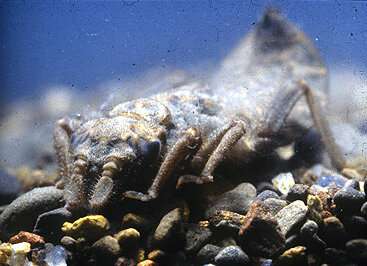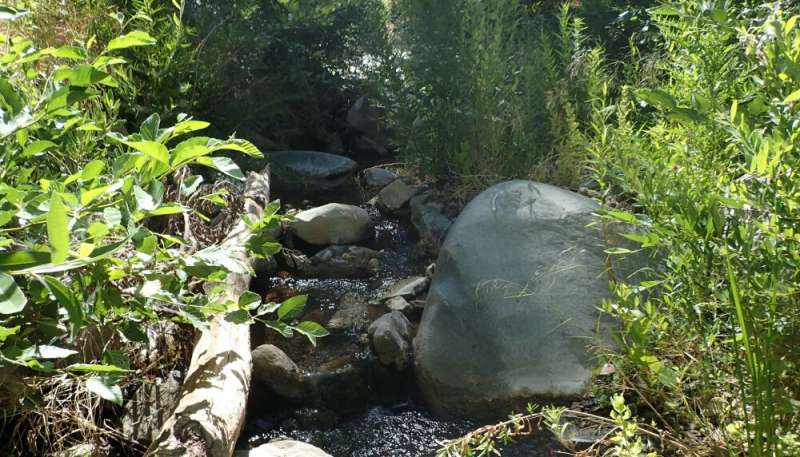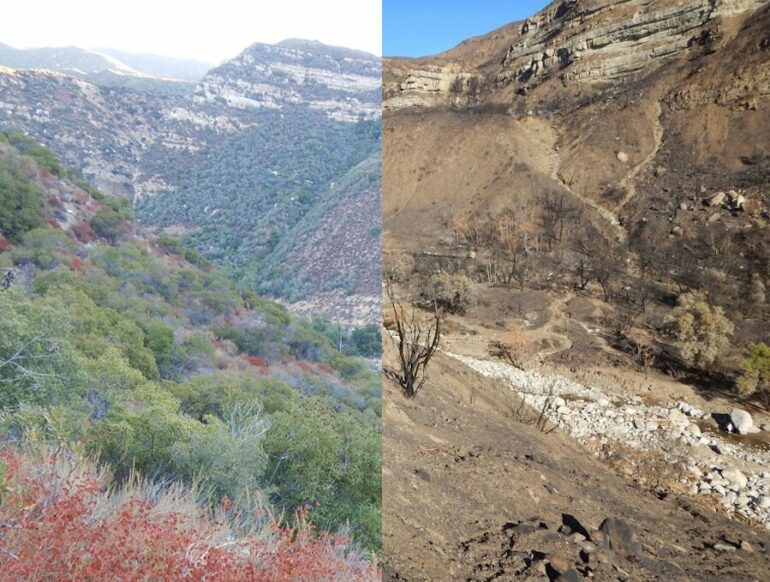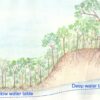Life is water, and water is life. This truism certainly applies to the Pacific coast, where streams and rivers function as the region’s arteries. The water they carry fosters plant life and wildlife in Southern California’s Mediterranean climate. They provide sanctuary during droughts and often serve as the nexus for recovery after fires.
Despite the importance of these waterways, scientists still don’t fully understand how they respond to fires. That’s why a team at UC Santa Barbara and the National Forest Service have studied wildfire impacts on streams over the past five years in parts of the Los Padres National Forest. The scientists’ new findings appear as the cover story in the December issue of Freshwater Science.
Three major themes emerged from their study: Legacy, contingency and change. A landscape’s current condition is a legacy of its history. Additionally, what happens to an ecosystem is contingent on a host of environmental conditions before and after a disturbance. These legacy and contingency effects are playing out against a background of climate change, with ecosystems moving into novel climate and land-use scenarios.
The results of this study also highlighted the significance of stream headwaters as refuges for sensitive aquatic species during fire and drought. After favorable conditions return, fish, amphibians and invertebrates can repopulate suitable downstream areas. This insight reinforced the importance of protecting these areas to ensure the resilience and biodiversity of watersheds as a whole.
A flurry of research activity followed the Zaca Fire in 2007 and Jesusita Fire in 2009. “That work showed that the riparian zone—the area of streamside vegetation—is really important in determining stream responses because if the riparian zone burns, it opens up the canopy,” said lead author Scott Cooper, a research professor in the Department of Ecology, Evolution, and Marine Biology. The added sunshine increases water temperatures and promotes algal growth, which in turn fosters a different community of algae-eating aquatic invertebrates. The reduced vegetation also results in increased runoff, erosion and sediment inputs that can change stream flow patterns, water quality and ultimately the community of animals in the stream.
The team planned to compare stream communities in burned and intact areas to study the legacy impacts of the Zaca Fire 10 years on. Then five years of drought complicated their plans. The drought’s effects were superimposed upon the fire’s effects, Cooper explained, leading to a multi-factor study contrasting perennial and intermittent streams, some of which burned while others didn’t.
“That’s just the nature of fieldwork,” said co-author Kristie Klose, Forest Fisheries Biologist for the Los Padres National Forest. “Things don’t always work out cleanly.”

Different invertebrates thrive under different conditions. This Octogomphus dragonfly naiad requires the shade of dense canopy cover. © Will Swalling
The team surveyed 30 streams in Los Padres National Forest and surrounding areas in 2016—at the end of a five-year drought—and again in 2017, after water returned and flows increased. They paid particular attention to the communities of invertebrates living in the creeks. Many of the sites were within, around and downstream from where fires had burned eight to ten years earlier.
In the short term, fires and landslides can increase creek flows because there are fewer plants drawing water from the soils and channels, Cooper explained. Increased flows during storms can scour streams and displace their flora and fauna, reducing their populations. Algae and certain invertebrates can quickly recolonize streams after flows recede, particularly if fire has opened up the riparian canopy. Streams often recover to pre-fire conditions within one to two years, he added, because vegetation quickly re-establishes in Mediterranean climates with their year-round growing seasons.
After 10 years, the team found that most stream communities had recovered from fires. The few that didn’t were species that preferred shaded streams with cool temperatures and abundant leaf litter. “A wildfire’s effects can be pretty short-lived in areas where the riparian zone doesn’t burn,” Cooper said. “Those communities usually come back within a year or two.” Impacts last longer where riparian vegetation does burn, and recovery of the stream depends on the recovery of the riparian zone.
Although streams had recovered 10 years after the last fire, the legacy effects of drought were much stronger. The major thing limiting the recovery of vegetation in Mediterranean climates is the availability of water. So droughts can really complicate the picture in ways that are not yet fully understood.
It’s still an open question whether drought hastens or delays an ecosystem’s reaction to fire. Fires often occur during droughts, when fuel is dry and temperatures are high. If these conditions continue, then the lack of water can slow the recovery of plants and delay a stream’s responses to later rain. On the other hand, heavy rains after a fire can cause floods, choke stream beds with sediment and, in extreme cases, lead to debris that remove most of the riparian vegetation. That said, rain can also promote the growth, which stabilizes soils and reduces erosion. “Over different timeframes, you can get very complicated results because rain can both stimulate plant growth while increasing stream disturbance,” Cooper said.
One thing consistently held true, though: Pools in stream headwaters were critical to the ecosystem’s recovery. “They’re refuges, through drought and wildfire, for fish and other aquatic animals,” Cooper said. “This is where sensitive species survive during inclement times, then recolonize downstream reaches when conditions become more amenable.” As a consequence, populations contract and expand through droughts, wildfires and favorable conditions, preventing the disappearance of species from creeks.
For example, the 2007 Zaca Fire burned large parts of the Manzana Creek watershed. “But its nearby tributaries, Davy Brown and Munch Creeks, did not burn and retained a dense riparian canopy,” Klose said. “They acted as refuges for endangered Southern California steelhead and protected California red-legged frogs.”

The riparian vegetation of Alder Creek took off after the Thomas fire destroyed water extraction infrastructure. © Kristie Klose
The findings underscore the importance of protecting these vulnerable headwaters. Drought is the new normal for the American West, and water scarcity threatens all of the region’s ecosystems, especially rivers and streams. What’s more, urban and agricultural demand for water is only set to grow, placing further stress on the region’s water supplies. For instance, the U.S. Forest Service issues special use permits for surface water extractions on the land it manages. According to Klose, we’re moving into an era where this may no longer be feasible. “In my lifetime, we’re seeing streams that were once perennial become more intermittent or even ephemeral,” she said. As streams dry, species that require perennial water, such as the steelhead, may be extirpated unless they have surface water refuges.
Some water extraction in the Los Padres National Forest ceased after the Thomas Fire destroyed infrastructure. “In those areas, riparian vegetation is burgeoning,” Klose said. This feeds back into a landscape’s susceptibility to fire. Native trees along streams are more resistant to burning due to their high moisture levels. Fires either stop at or jump over these zones depending on topography, Klose explained. And the presence of water ensures that riparian zones recover more quickly if they do burn. This is yet another reason to ensure the integrity of headwaters, according to Klose and Cooper.
As the lead aquatic biologist at Los Padres National Forest, Klose manages, conserves and rehabilitates aquatic habitat over two million acres of land. She said collaboration with researchers at UC Santa Barbara makes this possible. Additionally, the national forest hires four to five UCSB students to conduct surveys each summer. “This partnership also allows me to recruit and teach students hands-on field and lab skills that they can’t effectively learn in the classroom,” she added.
This study just scratches the surface of a multifaceted topic. Wildfires and the ensuing rains or drought vary in extent, timing, intensity, duration and magnitude. This results in a complicated, multi-dimensional matrix of fire and subsequent weather conditions. The researchers have continued monitoring stream responses to different fires and weather patterns, allowing them to fill in some of the combinations in this matrix.
Cooper, who has studied these systems for four decades, summed up the results. “There are two things I’ve concluded from being an ecologist: “Everything’s interconnected and everything’s dynamic.”
Research Biologist David Herbst; Staff Research Associate S. Matthew Drenner; and principal investigator, Assistant Professor Erika Eliason (all at UC Santa Barbara) were collaborators on this study, as was Jason White of South Coast Habitat Restoration.
More information:
Scott D. Cooper et al, Wildfire and drying legacies and stream invertebrate assemblages, Freshwater Science (2021). DOI: 10.1086/717416
Provided by
University of California – Santa Barbara
Citation:
Researchers investigate combined effect of drought, fire on stream communities, highlighting importance of headwaters (2021, December 1)



